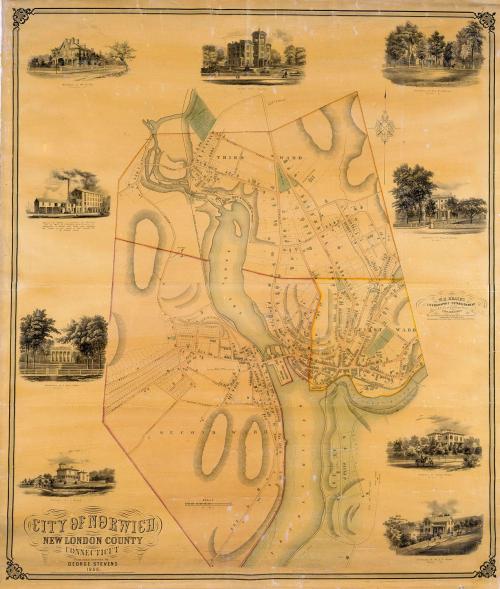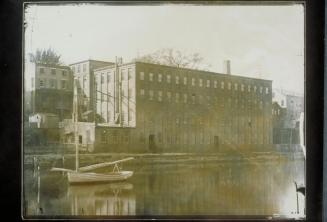City of Norwich, New London County, Connecticut
SurveyorSurveyed by
George Stevens
(American, active 1857 - 1858)
PrinterPrinted by
W. H. Rease's Lithographic Establishment
(American, 1844 - 1860)
PublisherCopyrighted by
George Stevens
(American, active 1857 - 1858)
Date1858
MediumLithography; black printer's ink and watercolor on wove paper mounted on fabric
DimensionsPrimary Dimensions (image height x width): 46 x 39 1/4in. (116.8 x 99.7cm)
Sheet (height x width): 49 x 41in. (124.5 x 104.1cm)
ClassificationsGraphics
Credit LineMuseum purchase
Object number1947.21.2
DescriptionMap of the city of Norwich, Connecticut, located on the Thames River at the confluence of the Yantic and Shetucket Rivers. Several bridges span the rivers. A large body of water above the Central Wharf and below Yantic Falls is identified as the Cove. The locations of several springs are shown. The city is divided into three wards. Streets are identified and houses and buildings are identified by street number. The New London, Willimantic and Palmer Railroad runs along the west bank of the Thames; the Norwich and Worcester Railroad runs along the right bank. Cemeteries, churches, parks, and some businesses are identified, including the town poor house, a ropewalk, a papermill, a gristmill, a coal yard, H. Bill's Laurel Hill Farm, and the Falls Manufacturing Company. Vignettes at the left, top, and right of the map depict the Norwich Free Academy, the premises of Myers and Bailey, Architects and Builders, and the residences of C. C. Brand, J. Hunt Adams, William W. Coit, Joseph Backus, Dr. J. V. Wilson, Charles N. Farnum, and General W. Williams.
Label TextThe city of Norwich, Connecticut depicted in this map is only a small portion of the town of Norwich, Connecticut. The central district, located where the Yantic and Shetucket Rivers come together to form the Thames, was incorporated as a city in 1784. Laurel Hill, which appears prominently at the lower right, was annexed to the city in 1857. The surrounding vignettes, which nearly all depict private residences, present a surprisingly gracious image of this bustling industrial center and transportation hub, an impression that is enhanced by the simple, uncrowded layout. The city of Norwich and the surrounding town would remain separate entities until 1952, when they were finally consolidated.
NotesCartographic Note: Approximately three and five/eighths inches equals 500 feetStatus
Not on view











